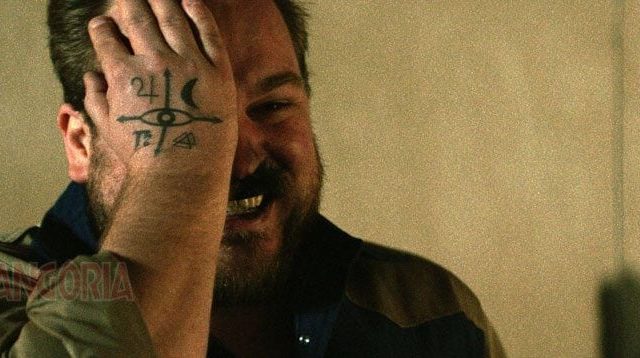2015’s Southbound bends some of the usual horror anthology conventions, and the result is an amorphous, unsettling movie that–while uneven–has some genuinely nightmarish moments. There’s no conventional frame story here, but the film is bracketed by two linked segments: “The Way Out” and “The Way In,” both directed by Radio Silence. “The Way Out” introduces us to two bloodied, exhausted men who are being followed by floating, skeletal wraiths. Fleeing their eerie pursuers gets more complicated when the two are drawn into a kind of contained space-time bubble–and this little meditation on acceptance and purgatory only gets weirder from there. In “The Way In,” we learn how they got bloodied and exhausted and why they’re being chased–but there’s new, similarly opaque backstory here. We can speculate, but there are no easy answers.
“The Way Out” shows us a sinister nowhere town in the middle of the desert, a place where the radio station constantly plays discursive, enigmatic broadcasts that seem aimed at individual listeners. (Sin, redemption, and regret are favorite themes.) One story leads to the next as ships pass in the night. The town is in on it, although it’s hard to say what “it” is. All our main characters are travelers, outsiders brushing up against the strange locals who manipulate them and facilitate their uncanny encounters with eldritch and/or hellish forces. Sometimes these residents aren’t quite human, even if they once were. Interacting with them is always a mistake.
Even the weaker segments of Southbound work on a powerful, intuitive nightmare logic. Roxanne Benjamin’s”Siren” –where a band’s van breaks down, forcing them to seek help from a too-cheerful family who, of course, turn out to be in a cult–has dark undercurrents about survivor’s guilt, with the story shaped by the overwhelming, relentless tug of it. Patrick Horvath’s “Jailbreak” features a man who has devoted his life to rescuing his sister from the town’s grip only to find out, to his horror, that she doesn’t want to leave, and the desperation, panic, and betrayal give an otherwise limited story some energizing emotion. (This story also has an excellently used hand tattoo.)
The best segment is David Bruckner’s relentless “The Accident,” which is the most universal and exquisitely nightmarish of them all. A distracted driver hits a woman with his car, and since he’s in the middle of nowhere, the emergency dispatcher tasks him with moving her broken, severely injured body to the nearest town. Then it gets worse. And worse. And spectacularly gory. This is an agonizing, relentlessly paced look at being drawn into an impossible, high-stakes situation, going from person to pawn to plaything, and shattering your life in the process.
Occasionally, horror movies use dream logic as an excuse to get away with vague, sloppy plotting, but Southbound makes it work at least 80% of the time. “The Accident” alone makes watching this one worth it, but everything here has a certain dark charm, a measure of inventiveness, and atmosphere to burn. “Gone south,” after all, means that something has taken a turn for the worse, and here we see, again and again, those gut-wrenching moments when life goes wrong. That vertigo-inducing sensation–my life has just gotten irretrievably worse–is one of horror’s best and bleakest motifs, and this movie makes the most of it.
Southbound is streaming for free on Tubi.

